Good morning everyone, and welcome back to the Mirror Gallery here on Hipsters of the Coast! Last time, we took a quick trip through the galaxy of some of my favorite artworks in Edge of Eternities, and before we depart for Universes Beyond (seemingly this month), I wanted to showcase two more artworks: Inspirit, Flagship Vessel by Titus Lunter and Extinguishor Battleship by Danny Schwartz.
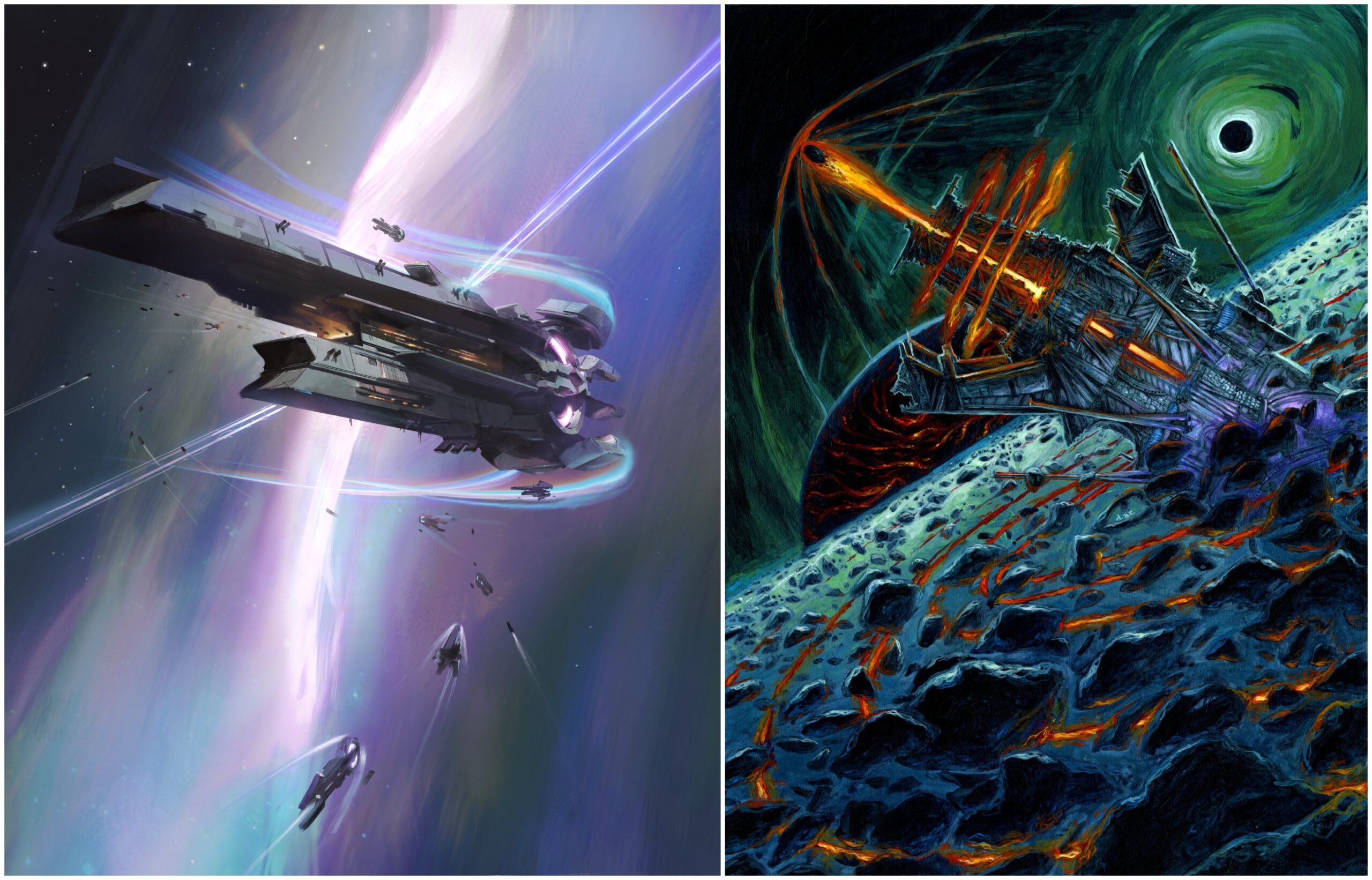
Left: Inspirit, Flagship Vessel by Titus Lunter. Digital.
Right: Extinguisher Battleship by Danny Schwartz. Traditional.
Both of these are new-to-Magic Spacecraft, pseudo-vehicles meant as an immersion to the unusual and unfamiliar space setting that is the Edge. From 93 million miles away these paintings may seem very different, in medium and in method. But in reality they are brothers, the the bookends of this entire set, and a brilliant and beautiful representation of why Edge of Eternities is such an aesthetic and artistic high note.
When an artist tells you that they think one of their new pieces is the best they’ve done for Magic, you listen. When two artists tell you that, you tell the world.
This is A Tale of Two Ships.
An Edge of Eternities Interview with Titus Lunter and Danny Schwartz
Donny Caltrider: Gentleman, good morning, and thanks for being here to tell us about your marquee pieces from Edge of Eternities! We’ll start as I’ve always done: Who are you, where are you from, and what do you do?.

Titus and his dog, Senna.
Titus Lunter: My name is Titus Lunter, I’m from the Netherlands and most of the time I am an illustrator. I started out 15 years ago as a concept artist for video games and slowly rolled into illustration work for projects like Magic: The Gathering but also Dungeons & Dragons, Legends of Avantris and many more. I really enjoy painting landscapes, though I dabble in other stuff as well. Outside of that I enjoy painting with pastels doing all kinds of wacky stuff.
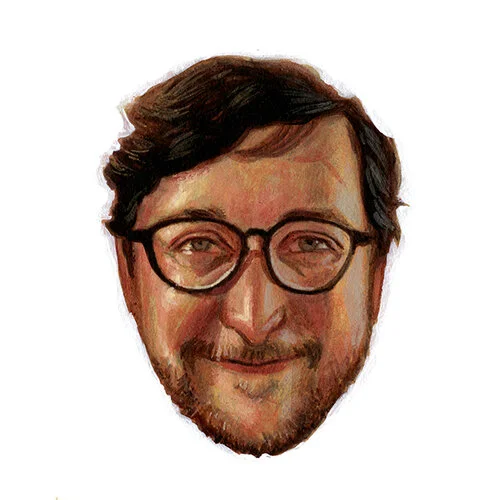
Danny Schwartz, as painted by Danny Schwartz
Danny Schwartz: I’m a fantasy illustrator from Westfield, New Jersey. I”ve been working full time as an illustrator for about 15 years now, wearing a variety of hats along the way – I started out as an editorial illustrator, working for magazines and newspapers like The Atlantic, The New York Times, etc., and sort of slowly transitioned out of that and towards more narrative and painterly imagery. I took a pit stop for couple of years in there where I worked as a character designer and animator at Late Nite Cartoons, a studio affiliated with the soon to be former Late Show with Stephen Colbert (we did a few television shows, including “Our Cartoon President”, and a couple of animated sequences for movies, like In and of Itself, which is on Hulu). I’ve been working in fantasy for about 6 years at this point – I work mainly for Magic, along with my own work for group shows in galleries across the United States.
DC: How did you start working with Magic?
TL: A friend of mine introduced me to the game in 2011, got me hooked right away and with some encouragement from them started applying to be an artist. After applying for about 3 years I got an email one rainy day asking if I had ever heard of the game and if I’d be interested. They had seen my realistic concept art I’d done for some videogames back then and wanted that skillset. That’s how I got to do my first lands for Khans of Tarkir – still an all time top 10 set – and the rest is history. As of this writing I have 191 unique artworks done in 12 years which, if I’m honest, I’m pretty proud of!
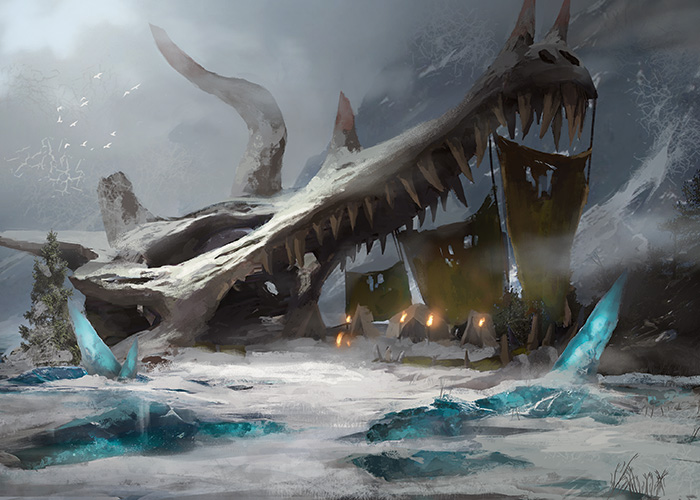
Frontier Bivouac by Titus Lunter, Digital
DS: I played Magic as a teenager – I wasn’t very good because I was more interested in the art than the game mechanics, and I found myself collecting the cards because I loved the pictures. I think I always wanted to head in this direction but I could not understand a path to get here – the level of technical skill required is so great, and it’s very difficult, I think, for a young person to understand that there really isn’t a shortcut – developing those skills takes time and lots of practice.
I started working for Magic in 2022 in the aftermath of the Streets of New Capenna release. A number of friends and artists I admired and had gotten to know had work in the set and I felt that there was a real moment where my level of stylization, combined with my abilities as a painter, were suddenly in a place where there might be a window for me to join future sets. I like to tell friends, when I tell this story, that Kamigawa: Neon Dynasty is what got my attention and made me start dreaming and working towards this again, and Streets of New Capenna is what made me feel I was ready. It was very fast, they came out one after another, but it was a profound time of change for me. I emailed a few of the art directors in the days after New Capenna was released and I was so lucky to be picked up for Wilds of Eldraine shortly after. It’s been pretty regular ever since and I’ve loved every second. I never want to stop.
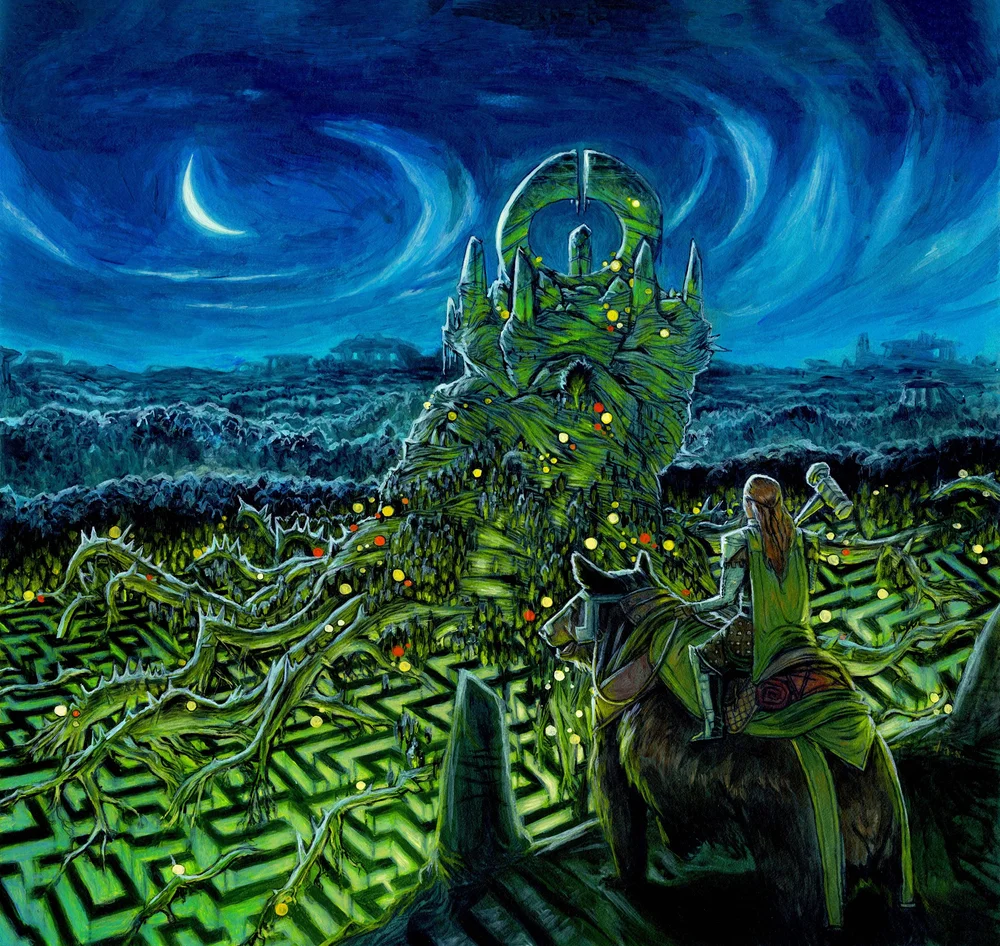
Virtue of Strength by Danny Schwartz. Traditional. His first card for Magic.
DC: How would you describe your style? And how might others?
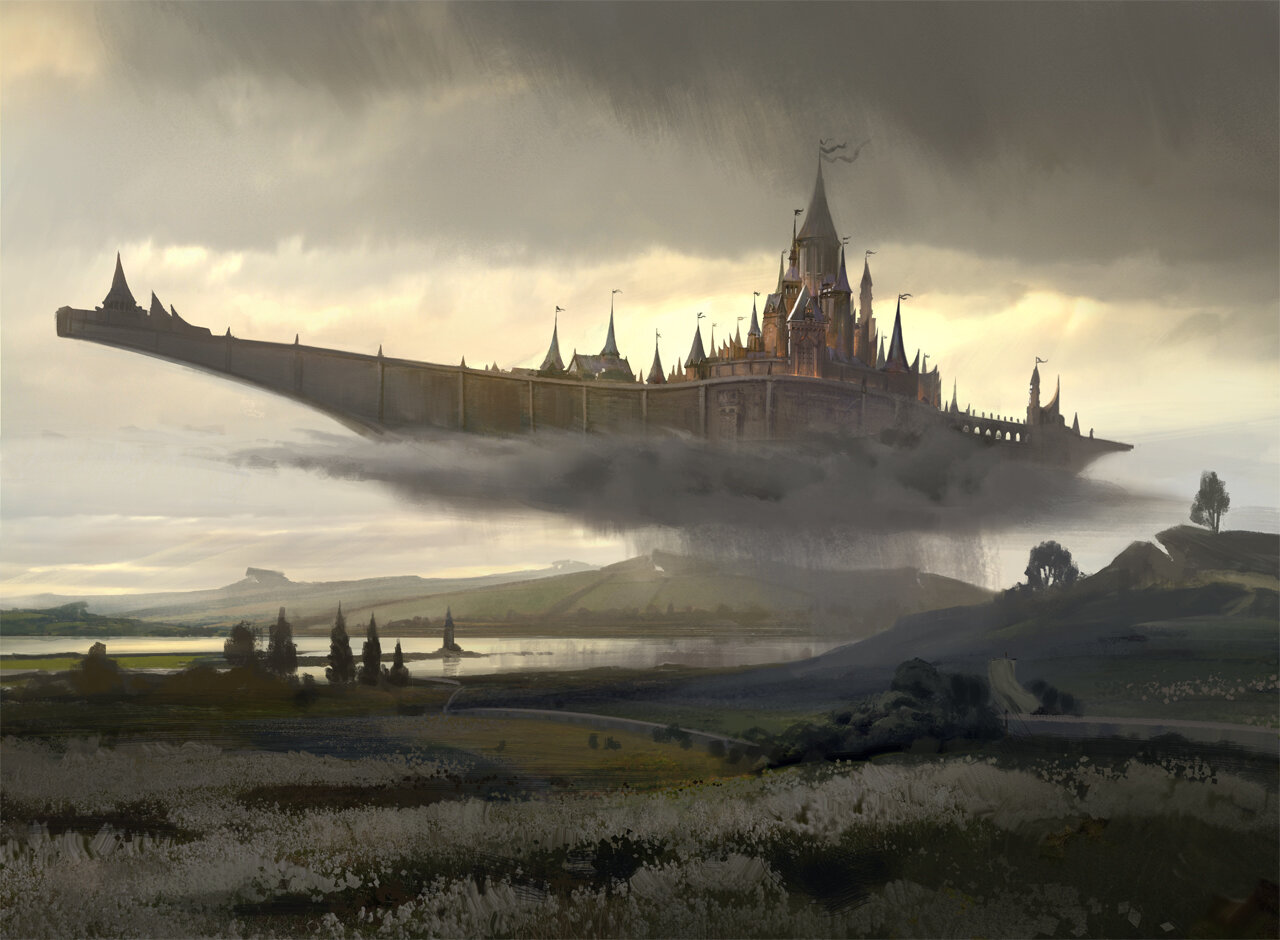
Castle Locthwain by Titus Lunter. Digital.
TL: Realistic. Atmospheric. Maybe with a hint of orientalism, and monumentalism? But, let’s not put too fine a point on it. I like painting landscapes, real or stylized, fantastical or grounded, and a big part of what I’m trying to do is to transport the viewer into the painting. Give them something they will recognise, another sense – like the feeling of a warm summer breeze blowing, or booming thunder in the distance. So, whichever word anyone uses to describe my work I hope it’s one that captures a little part of that.
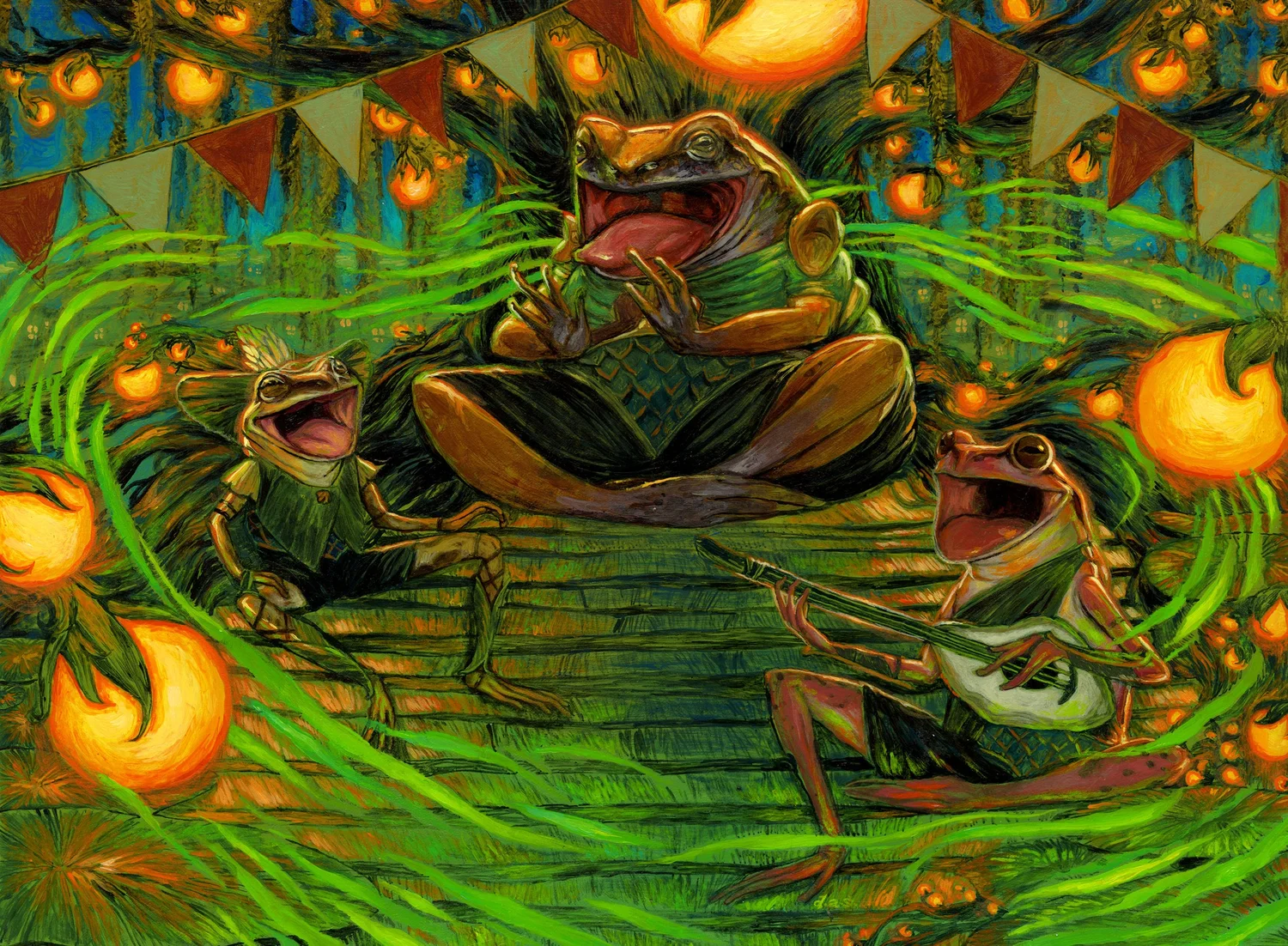
Harmonize by Danny Schwartz. Traditional.
DS: My work is very character driven, but I’m known to include abstract elements here and there when they suit the piece and solve a problem. I love lush, deep colors and I love playing with perspective and form. My favorite assignments for Magic (and my favorite paintings to make anywhere else, really) are when I can tell a story and do some world building, deepening the viewer’s understanding of characters and the world they live in. I get assigned a lot of spells as a result – they fit the bill pretty nicely. Mostly I’m pretty whimsical, but I try to be elastic to suit the assignment, whether it’s serious and dark or light and snappy. No matter the mood, I’m always pushing for authentic moments of beauty. I work traditionally in acrylics.
DC: What gets you inspired?
TL: I think, for those curious enough, there are still a lot of mundane things that can inspire a sense of wonder. I think as adults many of us lose that luxury through the hustle and bustle of life. It’s hard to be amazed by the clouds if you have to worry about bills or if you’re in a rush to pick up kids from daycare. As an artist you’re kind of forced to create time for this, to have an on and off button for it, and as a result that curiosity will allow for inspiration to pop up from nowhere.
If you’re lucky enough, you’ll find something so intriguing that it won’t let you go, which not only inspires you but also gives you motivation. When researching stuff online I always feel a bit like Indiana Jones, trying to uncover hidden treasures. Except, then not steal them from the locals to put in a museum, but like, to use as inspiration.
DS: When I was a kid, my mom would take me and my brothers to the American Museum of Natural History in New York a few times a year – we lived not far, in suburban NJ. My favorite things to look at there were the animal dioramas. The Hall of North American Mammals is particularly good – they’re all set up, weirdly, like Magic cards, almost?

Hall of North American Mammals. Opossum & Might of the Meek by Danny Schwartz. Image: NAHM
You can look into them and they’re all set up with little narratives, and the closer you look the more detail you can spot that tells the story of the animals pictured and the little pieces that make up their world. And the background paintings are beyond gorgeous – you feel like you can just fall into them forever. When I look at them even now I feel this strong, sad tug towards something. Places I haven’t been and couldn’t even have imagined, where the sky is huge and open and everything is new and familiar at the same time and the world is bathed in color. Each diorama is like a door to the unknown, beckoning you to be a better functioning gear in the great machine of the universe. That’s the kind of moment that gets me going. Sometimes you experience these beautiful snapshots in real life, like on an especially colorful summer evening, or a night in the city, or on a trip somewhere new. Sometimes I sense them at a particularly poignant moment in a book or movie or video game. I don’t really have a word for the feeling but I’m always chasing it.
Edge of Eternities: Inspirit, Flagship Vessel & Extinguisher Battleship
DC: What sort of direction did you receive on this piece at the beginning from your Art Director?
TL: My brief was pretty short and very sweet – a colossal spaceship, fleets of smaller ships moving in and out, powered by a large cylindrical drive, hanging in space looking very impressive. The mood was Colossal Power, hence me having it shoot a few laserbeams. The AD was Zack Stella and he knows I’m a sucker for sci-fi, I’ve been pestering WotC to do a set like that for years. I felt very at home with this brief.
DS: My brief for this was actually pretty simple – to design a very large asteroid throwing spacecraft that uses a huge rail gun to shoot asteroids across space. For scale they told me it was very nearly planet-sized, so I should consider adding some moons or something like that nearby for scale. Sam Padilla was my AD.
DC: Take me on a quick trip through your process, and let’s see some sketches!
TL: Normally I go back and forth quite a lot, I’m not a terribly confident painter in the first (or last) steps, usually I can’t make up my mind. But in this case within minutes of getting the brief I sketched a few ideas on paper, first in a very small notepad which I usually use for just testing markers and quick thoughts, and second on a slightly nicer sketchpad.
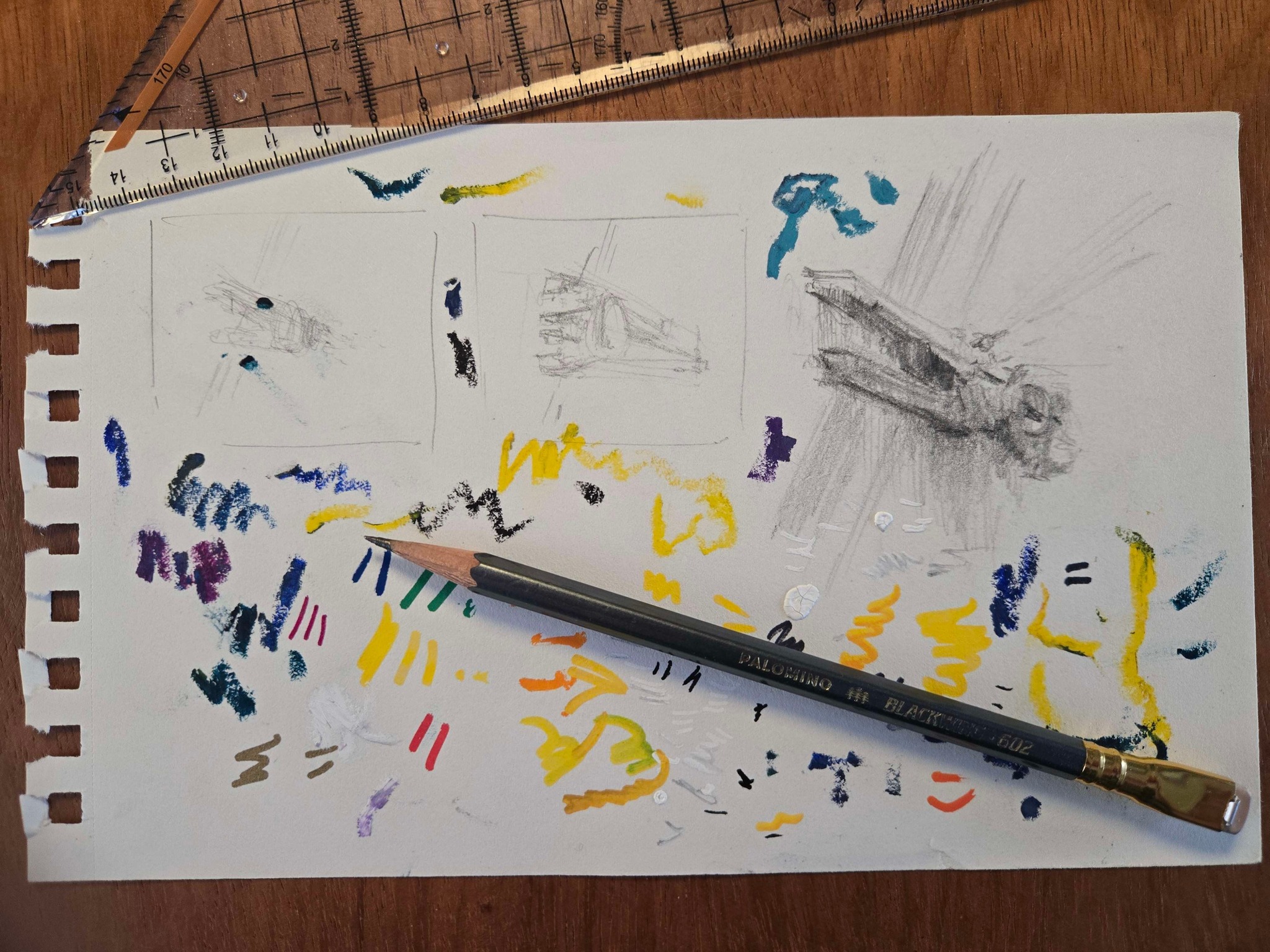
Shared with permission from WOTC- TM and © Wizards of the Coast
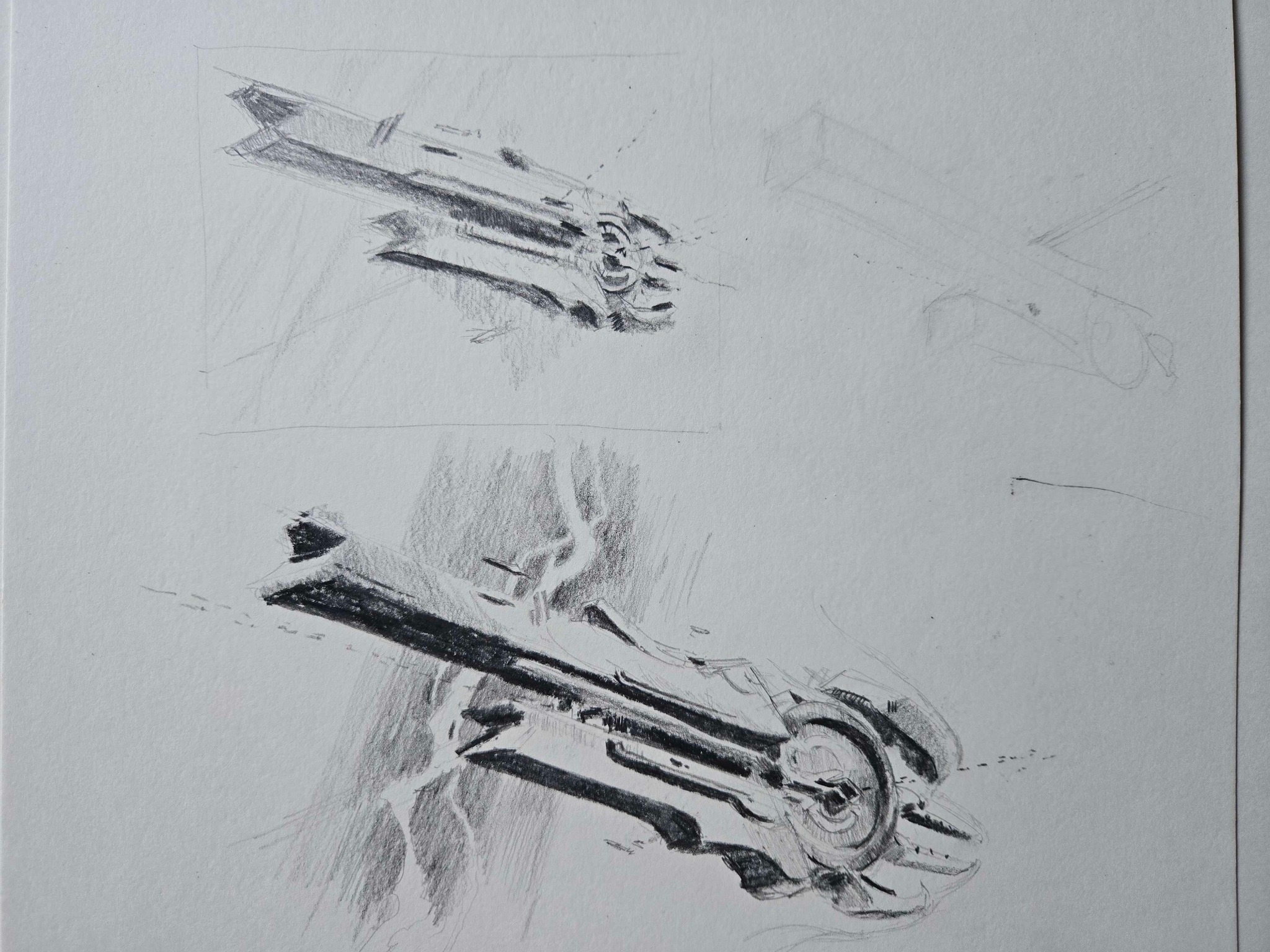
Shared with permission from WOTC- TM and © Wizards of the Coast
Once I saw those compositions I knew that was the shot I wanted. To make my life easy I made a quick 3D model of the ship to capture the complexities and also to layer the story a bit more with interesting shadows. With these large complex forms it’s less about the silhouette and more about the rhythm the entire thing creates once lit. For colors I went with some great palettes I found in the styleguide they provided, creating a harmony between the backdrop and the warpfield effect. Once the piece settled in nicely I took my time creating all the little spaceships flying in and out. It was a very zen process because it was so much in my comfort zone that I hardly had time to panic about stuff, which is always refreshing.
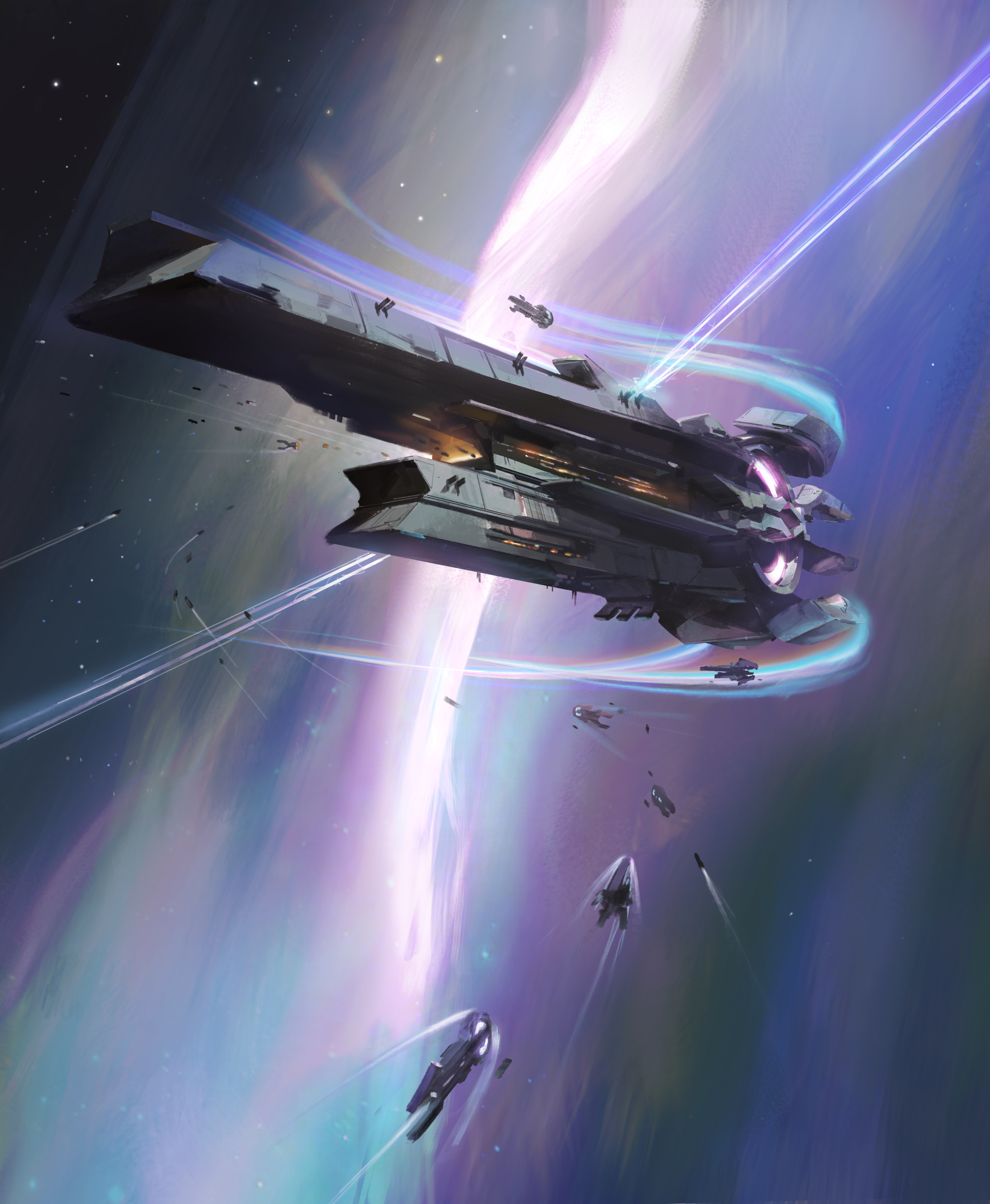
Inspirit, Flagship Vessel by Titus Lunter. Digital.
DS: I was very, very, excited to design my own space ship. I had spent quite a bit of time as a kid designing and building a fleet of space ships out of Legos and drawing them in my sketchbooks, particularly in the aftermath of my exposure to Star Wars, which hooked me for life. Doing it again for the first time in many years, maybe even decades, felt so natural, like fitting on a glove, except this time I had years of training and experience and could… actually draw what I was picturing. It was exhilarating.
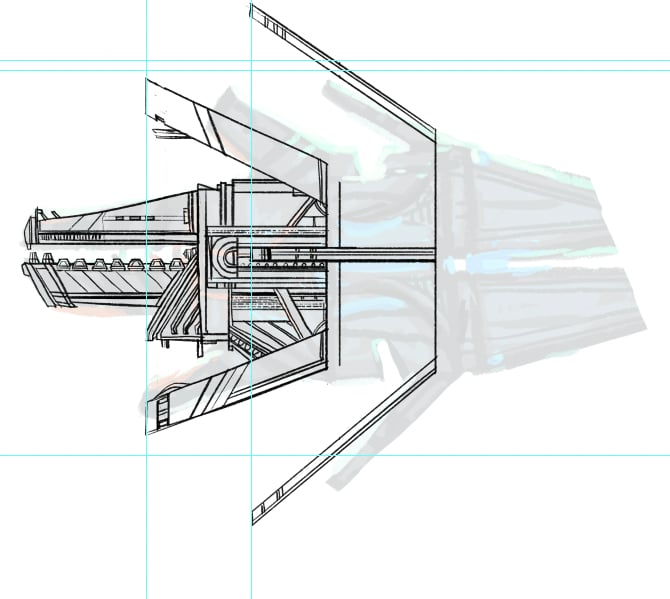
Ship Design. Shared with permission from WOTC- TM and © Wizards of the Coast
I did a bunch of different sketches trying to hone in on a design and briefly considered building a physical maquette out of clay as I got closer to a final design – but I ultimately decided that given how complex I was getting, that might take nearly as long as doing the painting itself, so I settled for reference made of paper and found objects for lighting (a rail gun has more than a passing resemblance to a stapler).
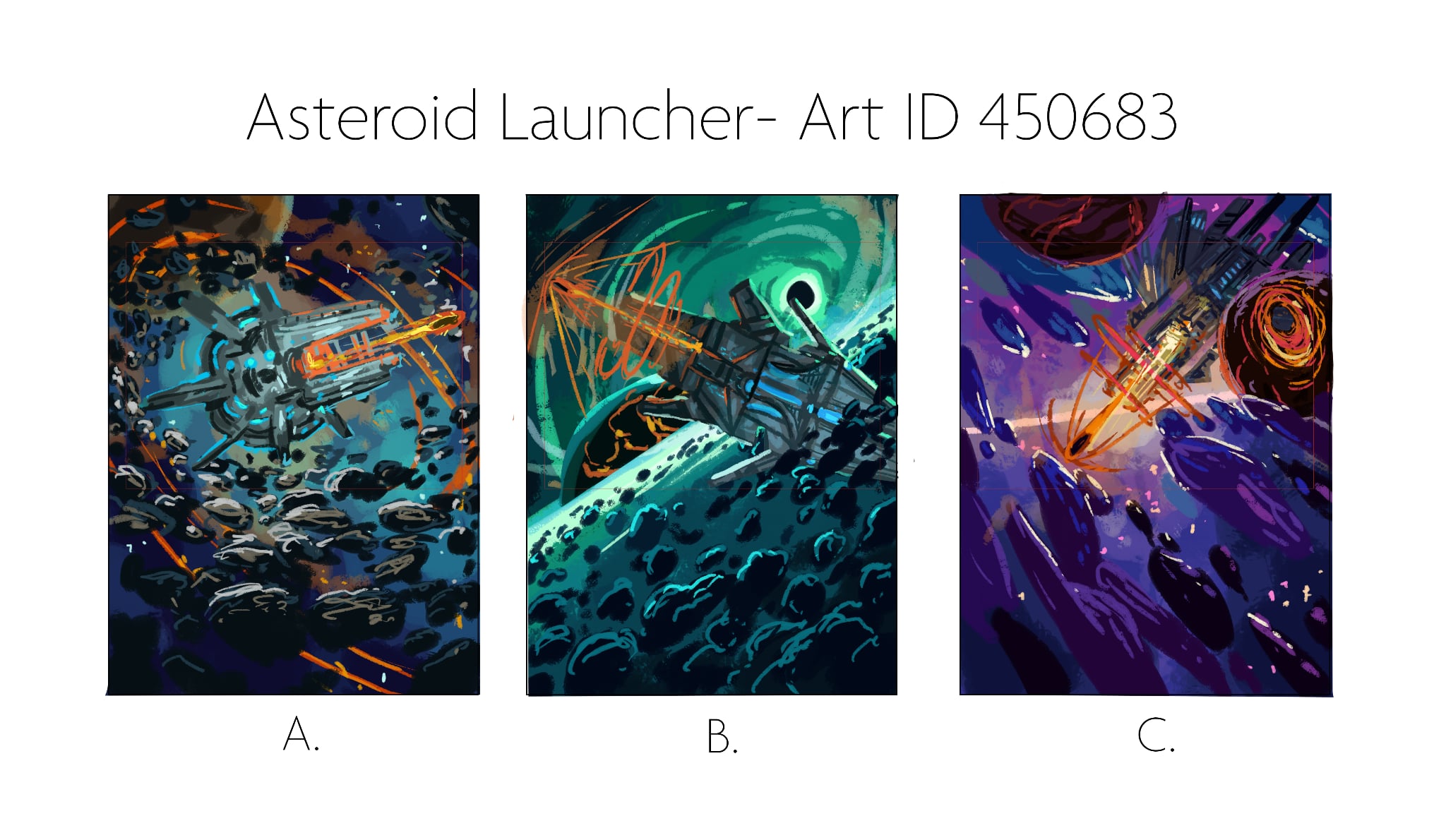
Compositional Sketches. Shared with permission from WOTC- TM and © Wizards of the Coast
From there, my normal process took over – compositional sketches in full color, done digitally so I could be as free and fast with different choices as possible, and then once one was approved, a graphite drawing on an illustration board for the final design before I start to paint, directly on top of the drawing.
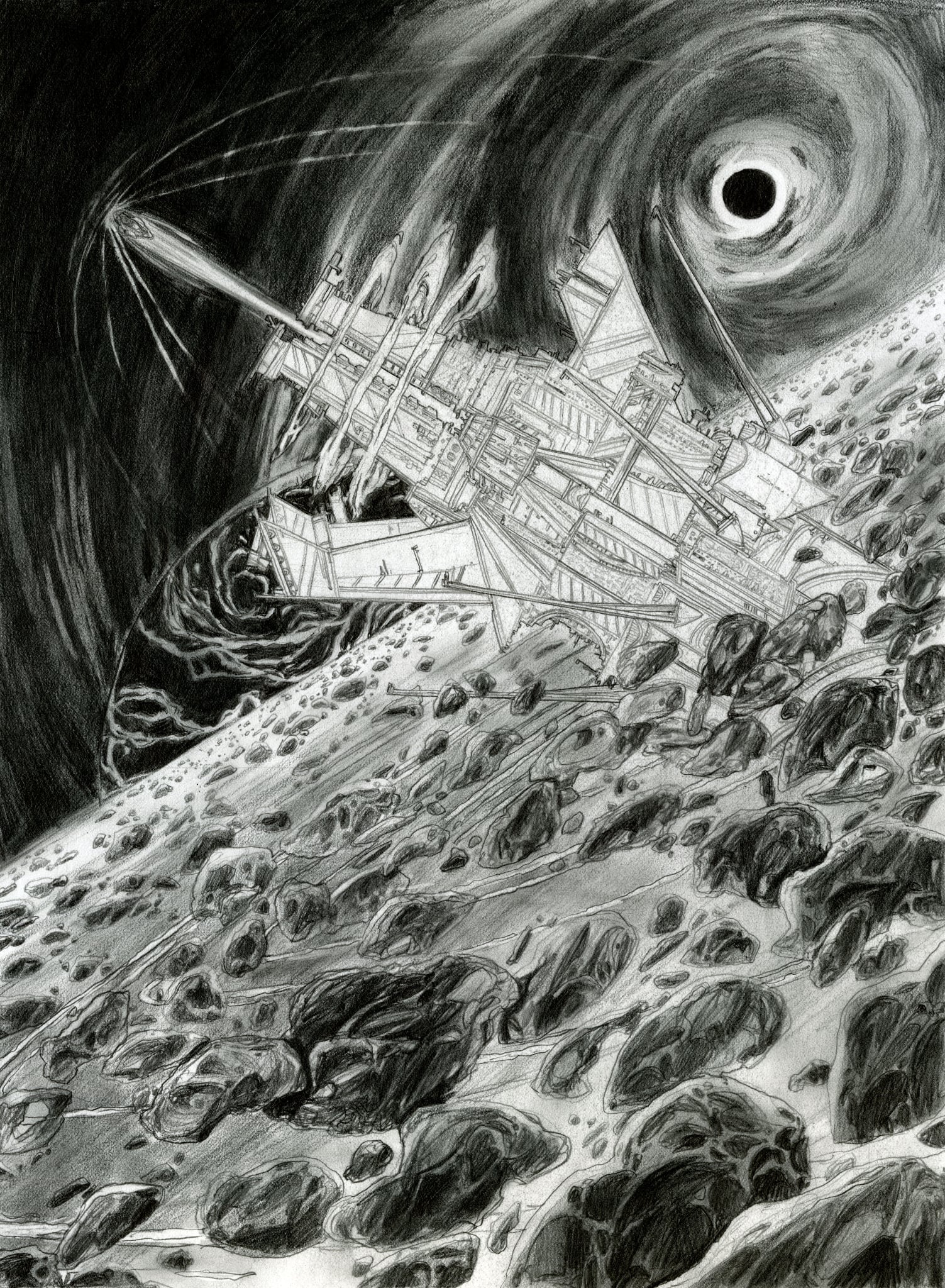
Graphite Sketch. Shared with permission from WOTC- TM and © Wizards of the Coast
I don’t usually remember this, but for this image I was very careful to start with entirely new brushes so that I could be sure I’d have the fine points required for the level of detail work I knew I’d need to achieve on the ship.
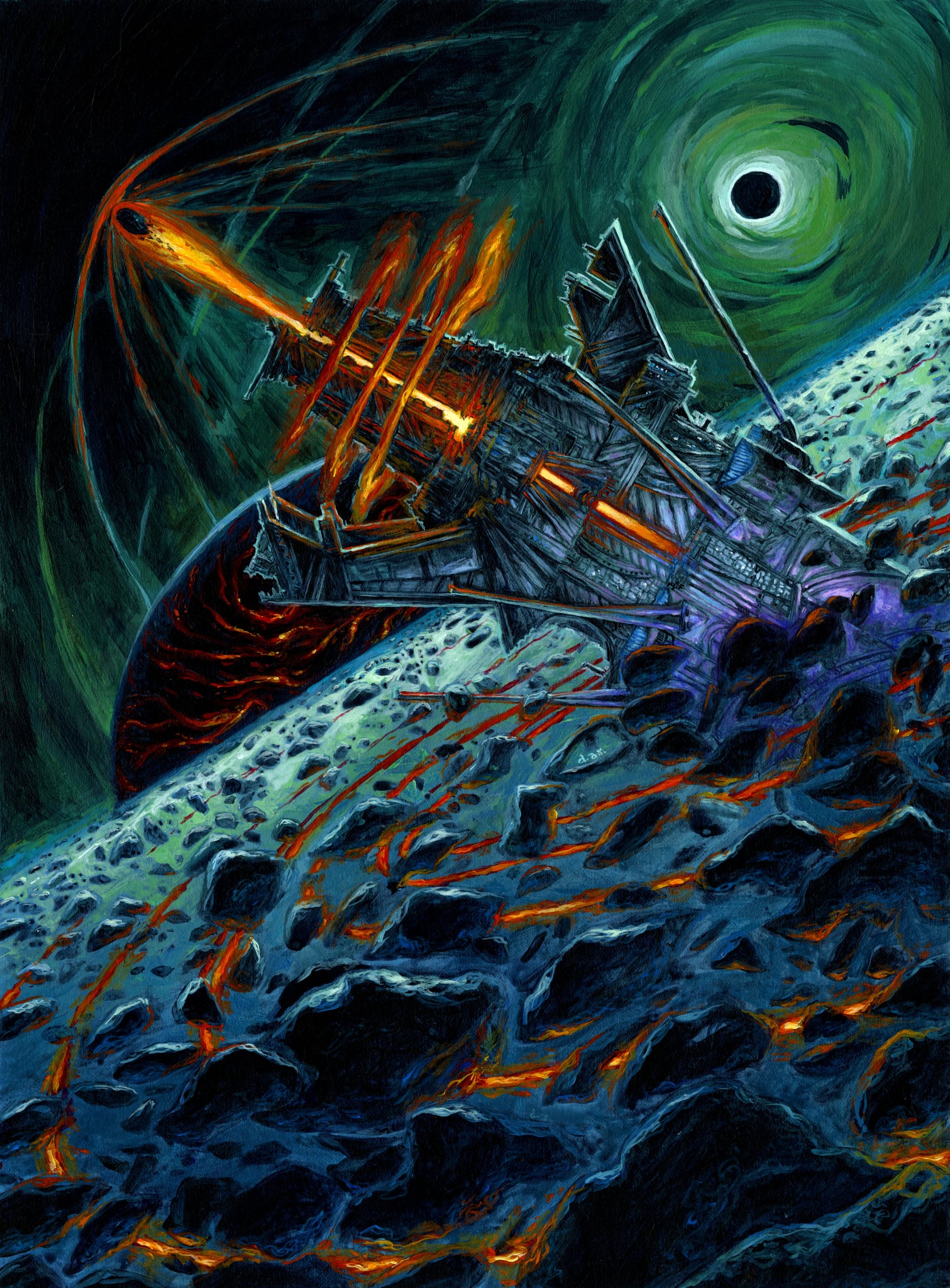
Extinguisher Battleship by Danny Schwartz. Traditional.
DC: What’s something we wouldn’t know just looking at your piece that you find particularly special or exciting?
TL: One of my favorite pieces is the Sulaco by Syd Mead done for Aliens. There are a lot of other fantastic examples of sci-fi art and artists, but the sheer size and power coming from that illustration has stuck with me for years.
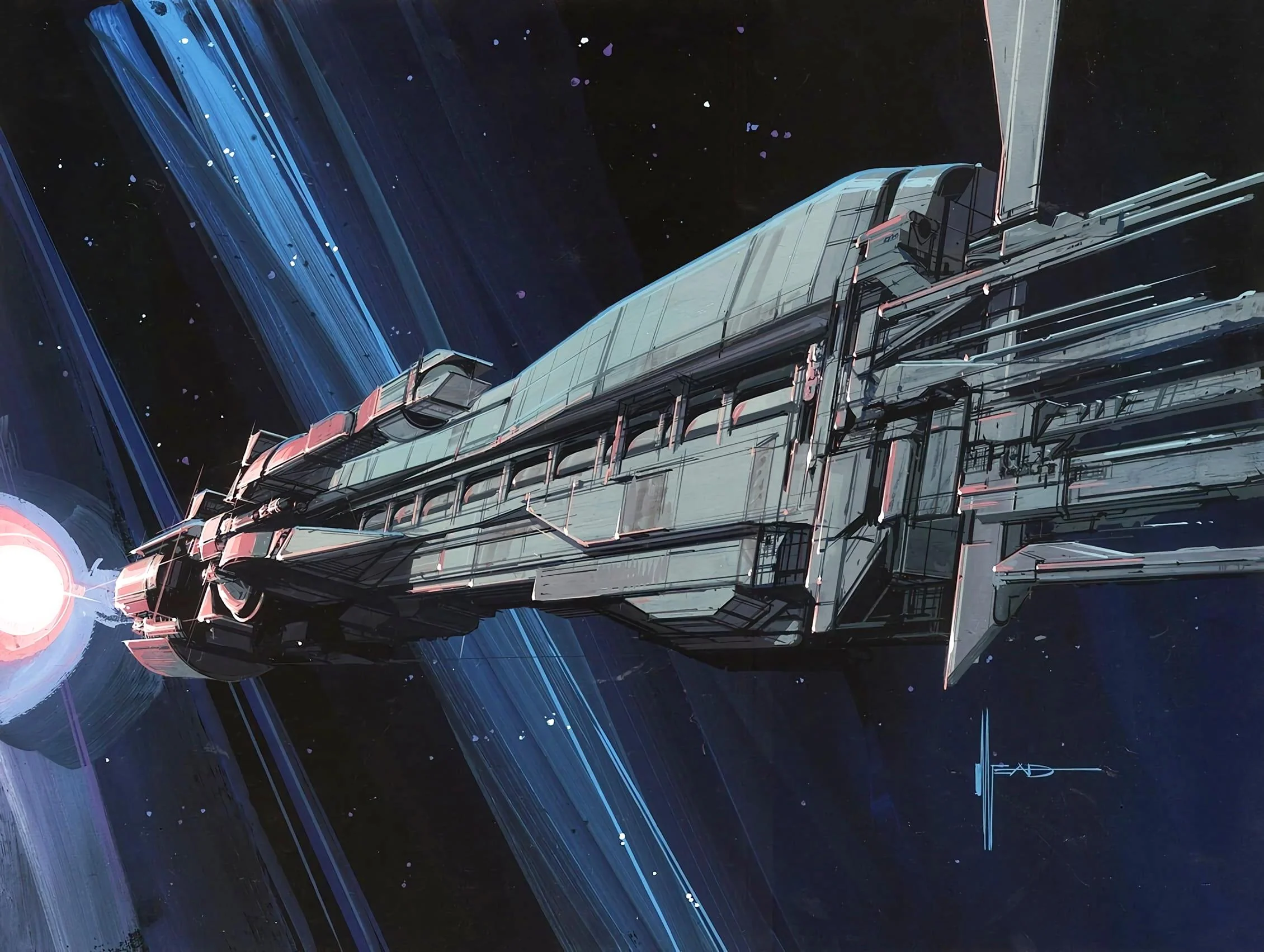
Sulaco by Syd Mead
This painting kind of became my tribute to that feeling. I have a deep fascination with space because it evokes a sense of exploration that is hard to get these days. Even though our days of exploration here on earth have only recently slowed, with only the most difficult parts of the ocean left, it leaves a feeling of wanderlust unanswered. Ironically I try to capture that from the comfort of my own home, but I feel I’m allowed a tiny bit of hypocrisy, provided I paint it well.
DS: This is a hard one to answer but I would just say all the different influences I had when imagining how to put this together. The big one is Titan A.E., a really wonderful animated film from 2000 that, put embarrassingly simply, involved large battleships shaped quite a bit like this one shooting really powerful space-beams for various purposes. The climax at the end of the movie even features a ship firing from the center of a large asteroid field. I have loved that movie since the second I saw it and I wanted to pay tribute as best I could. Then of course there’s Mass Effect, probably my favorite science fiction story of all time – I think they do a great job of filling the vastness of space with color, and really helped me get into the mood for the depiction of space we were going for in Edge of Eternities. They did this thing with an arc shape that feels so science fiction to me, and trying to hit that note is a big part of how and why I depicted that moon in the background.
DC: And finally what’s the smoking gun; what really makes this illustration work?
TL: It’s bright and colorful and keeps people’s attention, second it’s a massive toy. It has a sense of play, you run around and go pew-pew. Though this ship can also be used for peaceful missions and is excellent at tea-parties. It works because I love it, and I think it shows that I do.
DS: For me it’s that volcanic moon in the background. The art direction to include one for scale was incredibly wise – showing scale in an alien and unknowable space like, uh, space, is a tough nut to crack and a relatable shape like a moon or planetoid is helpful for both the viewer and the artist. But my favorite thing about it is the color combination of purples and oranges and reds and blues (for the atmosphere) that both set it off as a distinct shape, show distance from the viewer and the ship, and help define the shape and colors of the ship. I love it. It’s my MVP planet. It’s my favorite thing to look at in this image. From this distance, it also feels pleasantly warm in a relatively cold scene.
Reflection
DC: You both mentioned that this is among the best work you’ve ever done for Magic. What puts this piece over the top for you?
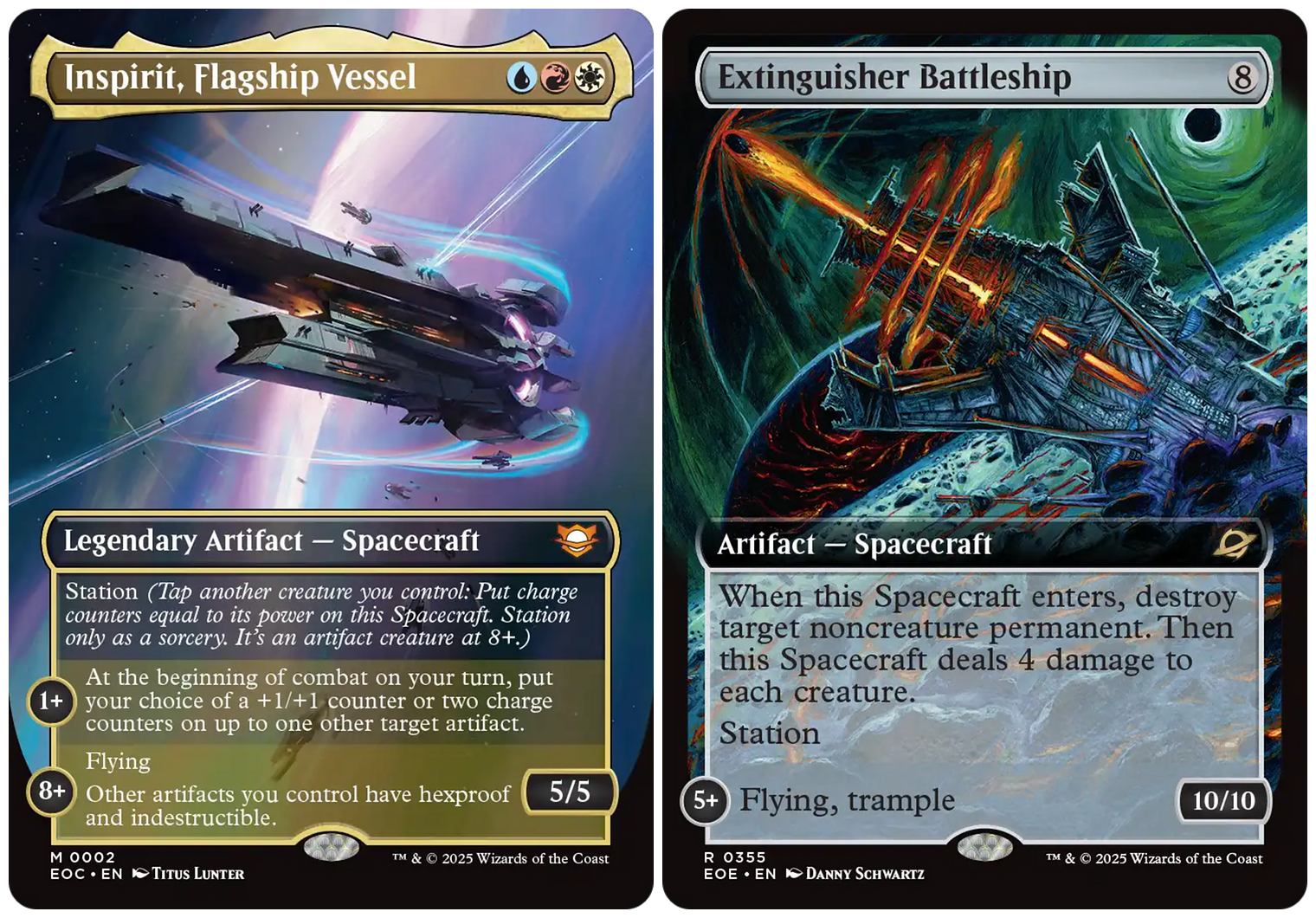
Inspirit, Flagship Vessel by Titus Lunter and Extinguisher Battleship by Danny Schwartz.
TL: It’s very easy for an illustrator to move the slider too far into the direction of what the client wants versus how you want to do it. We all want to be in that position where we get to do our vision of whatever the brief is, but the reality is that very few of us get to do that – which makes sense, we’re here to tell a story and we do that in collaboration with the writers and art team of course. But, every so often sets and assignments roll along which overlap perfectly with how you like to work and what you see as a good illustration – it allows you to be unabashedly biased. That inspires a sense of confidence that, at least for me, is not guaranteed in all pieces, and as such you get this x-factor in it.
Georges Braque said: “There is only one valuable thing in art: The thing you cannot explain”
I believe as well that, to define everything is to kill it, the mistakes, the things left out is what makes it great. Which is no easy feat in illustration, it’s less literal here and more figurative. What I mean is, I feel these pieces of mine in this set suggest a whole universe, believable and unseen, which give the paintings weight. They become part of an idea, a curiosity, which is interesting and robust.
DS: At the risk of being repetitive: the sense of scale. I honestly didn’t know if I could pull it off in my own visual language before I started, but I jumped, and I’m still surprised and delighted over a year later that I pulled it off. The ship looks big. The space looks big. I was able to restrain myself where I needed to be restrained so space could be big and open, and also keep the composition moving.
A lot of the joy for me in illustrating for Magic comes from moments like this. We switch it up pretty often, going from plane to plane and you don’t really get a moment to ask yourself like, “wait, can I paint space?” You just have to jump. It’s a challenge in the best way. How can I bring everything I have learned to this moment, and maybe even say something new, while respecting the vibe the set is going for? A lot of the time assignments make me go right up to and maybe even past the edge of what I perceive to be the limits of my abilities. It can be scary but it’s also exhilarating. Pushing against that limit again and again surprises me often – I’m capable of far more than what I imagine for myself, I think – and makes me feel like I’m growing and learning all the time. Sometimes it doesn’t work and you fall on your face a bit and have to figure out how to save things. I was delighted that this wasn’t one of those times, and I was able to write a love letter to some of my favorite stories and imagery, in my own voice.
DC: Do you have anything else exciting in the works, with Magic or otherwise?
TL: Yes, both. I’ll show it all soon enough, but for now I enjoy my bubble a lot. I feel that away from the light I’m making some of my most interesting stuff. I want to cherish that for just a bit longer.
DS: Yes. This image was actually the last image I did for Edge of Eternities and it launched me into a spree of some of my most ambitious work for Magic that hasn’t really ceased. I pushed past something here – maybe with scale, maybe with color, maybe just something about myself – that unlocked a new level for me. Lorwyn Eclipsed is our next big main set release, in January of 2026. I have some of my favorite work ever in that set, and I think this painting was a vital step for me in making it, which is pretty funny considering the vast difference in settings.
DC: Where can we find you online to follow your work?
TL: tituslunter.com – I’m off social media, portfolio websites, the lot. But feel free to email me whenever, I’m usually down for a chat.
DS: You can find me on Instagram and Bluesky (my handle on both is @dannyschwartzart) and my website for my formal portfolio (updated somewhat less frequently).
DC: Guys, thank you both so much for this immense insight. This deep dive was truly a delight, and I’m so glad that these pieces are in this set to show the sheer possibilities of Magic: The Gathering artwork.
Wrapping Up
These two pieces frame the art of this release, a science fiction Argonath between where we’ve been, and what lies ahead at the Edge. From the realistic and rendered to the stylized and figurative, they prove there is room for everyone in this game, and even stylistic opposites have a dialogue, telling a harmonious story and building a world nothing short of fantastic. I have known both of these artists for quite some time now, and it’s a sincere joy to see them rise to the top, producing some of their best work for Magic, and leaving a noted mark unmistakable by their hand.
We’ll soon be leaving the Edge of Eternities for New York City and the next Universes Beyond release, Marvel’s Spider-Man. I’m usually not one for writing on Universes Beyond, but I have written quite a bit about Marvel trading card artwork, so stay tuned for what I might be able to whip up. Thanks for reading, and see you next time.
Donny Caltrider works with Titus Lunter as his agent for original artwork, and with Danny Schwartz in offering his Magic: The Gathering artist proofs.
Donny Caltrider (he/him) has been writing about Magic: The Gathering art since 2018. He has an M.A. in Museum Studies from Johns Hopkins University, and works in varying capacities as an agent with nearly 50 Magic artists.
He likes baseball, Magic, good cards, great art, whiskey, and you.

